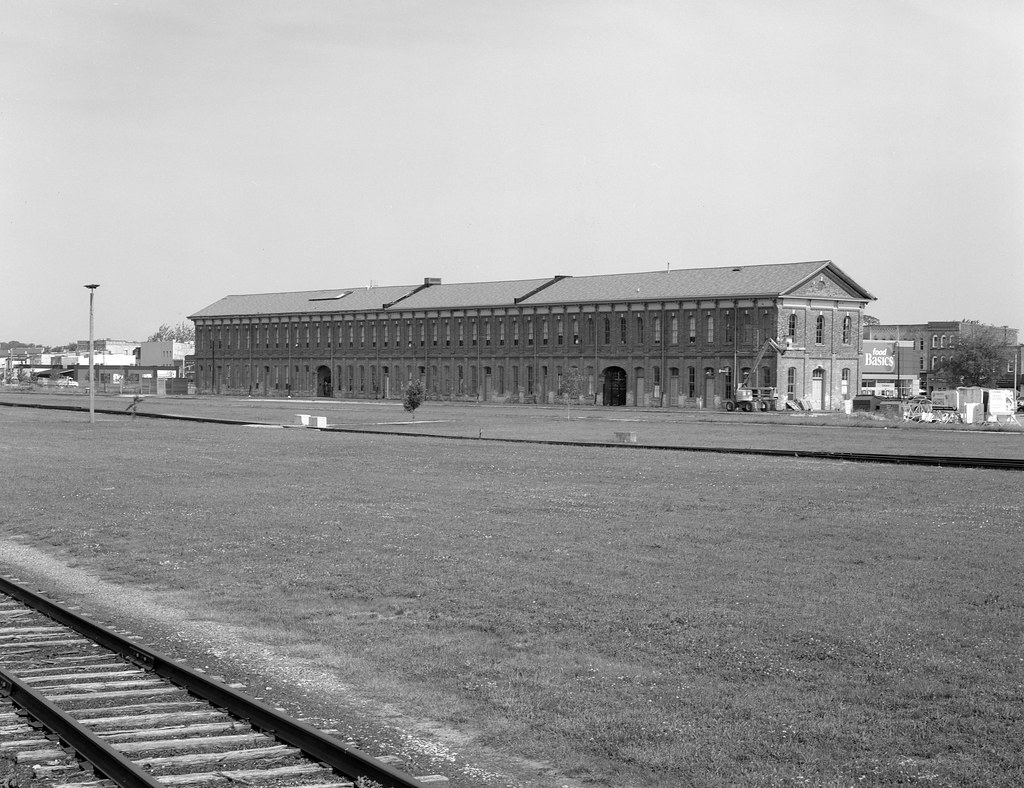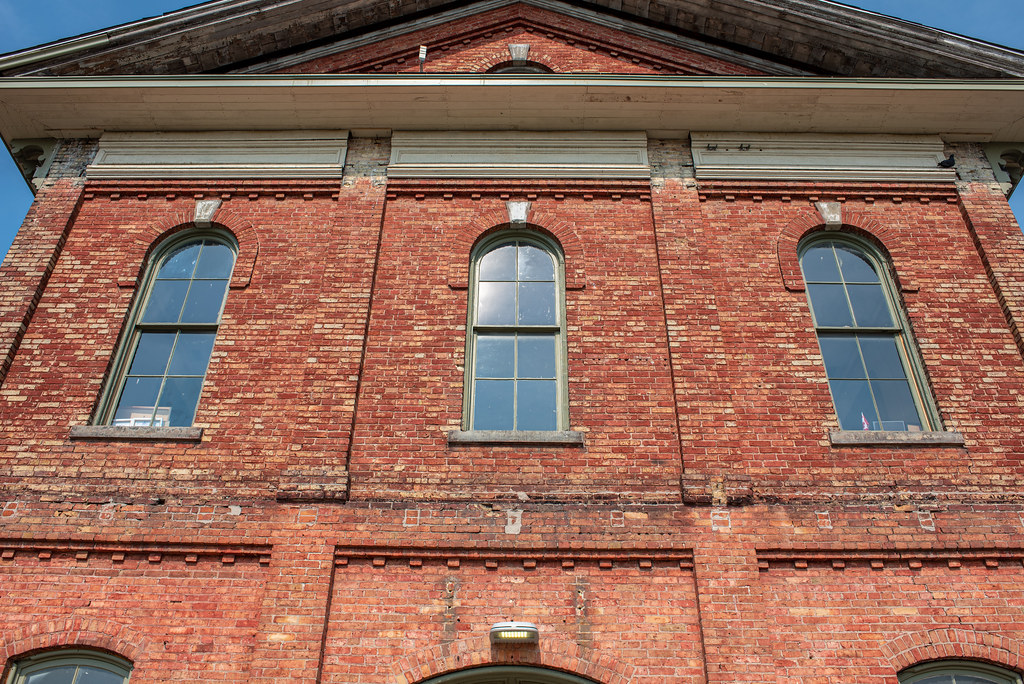Since the earliest day of the railway in Ontario, most controls lay with Canadian and British investors with some American investments. The biggest block for American rail in Canada was the requirement in the early days to have the lines built to Provincial Gauge to allow for Government money to support the construction and operation. But in 1873, the Federal Government took that requirement off the Railroad Act. This action and need for a native standard gauge railway saw the arrival of the only wholly American-owned railway, the Canadian Southern Railway, with CASO’s most excellent sounding reporting mark.

Graflex Crown Graphic – Schneider-Kreuznach Symmar-S 1:5.6/210 – Ilford HP5+ @ ASA-200 – Pyrocat-HD (1+1+100) 9:00 @ 20C
Initially chartered in 1868 as the Erie & Niagara Extension Railroad, the goal for the American investors was a line that ran from Fort Erie to Windsor, a shortcut through Canada to run American trains. Some early financial difficulties forced a recharter as Canadian Southern Railway a year later. Working with Isaac Beucanan for a survey route, the line ran straight through St. Thomas. The small town saw the advantage of being geographically in the centre of the Canadian Southern line, offering up a 25,000$ bonus and 310 acres of land if Canadian Southern constructed their headquarters and maintenance yards in St. Thomas. Despite being an American firm, they saw the value of having operations in Canada and couldn’t turn down the land offer. Construction kicked off in 1870. A year into the line structure, work started in St. Thomas. Designed by Canadian architect Edgar Beuyman, the station would be more significant than a town the size of St. Thomas would typically warrant. The reason is that the station doubled as the headquarters for Canadian Southern. Beuyman designed a simple Italianate station with a long rectangular footprint set back from the main street, backing onto the central yards for Canadian Southern. The St. Thomas station stood out in an age when most other Canadian operators designed stations in the Gothic Revival, Second Empire, or Beaux-Arts style. While the second floor houses the offices and spaces needed to run a railway, the first floor contains the passenger station. Two waiting rooms, one for ladies and families and a separate room for men. An agent office, ticket windows, and telegraph operator bay. A separate large baggage room stood on the first floor, along with an express room. Canadian Southern also included a full-service restaurant with a dedicated chef, kitchen staff and servers. The first train through the station came in 1872, with the final touches on the line completed by 1873.

Nikon D750 – AF-S Nikkor 28-70mm 1:2.8D
Nikon D750 – AF-S Nikkor 28-70mm 1:2.8D
The presence of the Canadian Southern, the station and yards put St. Thomas on the map as a Railway city as other lines quickly made a point to converge, notably the Credit Valley Railway. Credit Valley even adjusted its gauge from narrow to standard and focused on a branch line from Streetsville to St. Thomas (arriving in 1879). But for Canadian Southern, the rapid construction came at a cost, and they were bankrupt by the middle of the decade. Thankfully in the United States, a new investor stepped forward, and Canadian Southern became a part of the mighty Vanderbilt Railway empire. The station became one of the national renown, being named one of Canada’s best-looking stations. In 1883, the entire Canadian Southern network was leased out to Michigan Central Railway (another Vanderbilt-owned operator). Michigan Central did little to change the area, focusing mainly on the maintenance yards and bridge infrastructure to improve the speed and size of trains that could run through Canada. This lease would be extended to 999 years by 1904. The station suffered a fire in 1925 that destroyed the kitchen; rather than repair and reopened it, Michigan Central renovated it into a simple lunch counter. The need for a full restaurant had slipped like many long-distance trains, including dining cars in the train sets. By 1929 all of Michigan Central ended up being leased out to New York Central Railway (another Vanderbilt railway). During the post-war era, passenger service began to decline. While there’s no record of any major renovations being done, there’s a good chance that the separate waiting rooms were combined into a single space by the middle of the century. In a last-ditch effort, New York Central and the Pennsylvania Railroad merged into Penn Central, which barely lasted a decade before joining several other defunct operators to form CONRAIL in 1975. CONRAIL continued to use the station and yards for passenger services. By the 1980s, Canadian National and Canadian Pacific looking to secure access to the Michigan Central Rail Tunnel began investigating all former Canadian Southern assets; by 1985, the purchase had been complete. By this point, neither operator was running passenger services, and VIA had no need for the old station, so by 1989, the station had been shut down and closed. The final train ran the entire Canadian Southern route in 1996.

Nikon D750 – AF-S Nikkor 28-70mm 1:2.8D
Nikon D750 – AF-S Nikkor 28-70mm 1:2.8D
In 1996 the North American Railway Hall of Fame was formed to preserve, celebrate, and teach about rail heritage across Canada, the United States, and Mexico. Most of the former property assets that belonged to CASO ended up in the hands of ONTRACK, a holding firm looking to dispose of surplus property assets and support adaptive reuse. By 2005, ONTRACK looking to offload some property, attracted the attention of the Hall of Fame, who purchased the old CASO station in St. Thomas. The plan was twofold: to convert the station into a home for the Hall of Fame collection and increase income through event space construction. As the collection required additional funding, converting the first floor into a leasable commercial and event space took priority. The work proved harder than it first appeared, as the station had fallen into severe disrepair over several decades of closure. But in the Fall of 2005, a wedding occurred in the former ladies & family waiting room with the old kitchen again supplying catering services. As income and donations arrived, further work could restore the exterior, which was in serious need of cleaning and restoration and work completed. Today the station remains home to the Hall of Fame on the second floor and event space on the first floor. While it can be hard to find it far back and behind other commercial buildings, it is well worth visiting today.